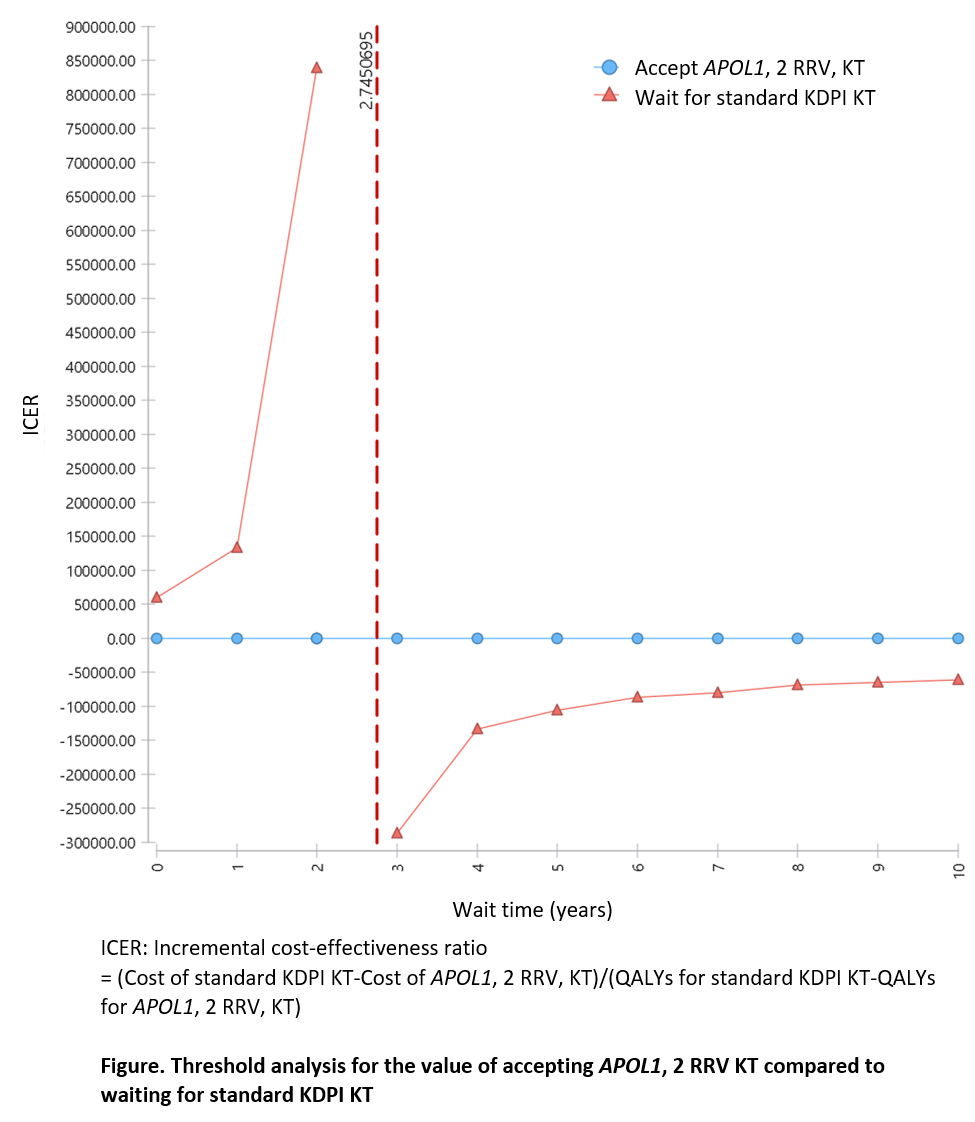How Long is the Wait Worthwhile: Cost-Effectiveness of Accepting a Kidney from a Donor with Apolipoprotein L1 High-Risk Genotype
1Saint Louis University, St. Louis, MO, 2Johns Hopkins, Baltimore, MD, 3Washington Univ, Saint Louis, MO, 4Saint Louis Univ, Saint Louis, MO, 5Univ of Iowa, Iowa City, IA, 6SRTR, Minneapolis, MN
Meeting: 2021 American Transplant Congress
Abstract number: 133
Keywords: Donors, marginal, Economics, Kidney transplantation, Outcome
Topic: Clinical Science » Kidney » Kidney Deceased Donor Selection
Session Information
Session Name: Kidney Deceased Donor Selection
Session Type: Rapid Fire Oral Abstract
Date: Sunday, June 6, 2021
Session Time: 4:30pm-5:30pm
 Presentation Time: 5:05pm-5:10pm
Presentation Time: 5:05pm-5:10pm
Location: Virtual
*Purpose: The Apolipoprotein L1 (APOL1) Long-Term Outcomes (APOLLO) study is underway to define the impact of kidney donor renal risk variants (RRVs) on the survival of kidney transplants (KTs) from African American donors. Pending completion of APOLLO, we conducted a preliminary cost-effectiveness analysis comparing acceptance of KT allografts with high-risk (2 RRV) APOL1 genotype versus waiting for standard Kidney Donor Profile Index (KDPI) <85% KTs.
*Methods: Discrete event simulation models with a lifetime horizon were constructed from the perspective of Medicare for 100,000 patients aged 50 to 60 years. Distributions of time to graft failure, dialysis, and death were estimated from the national Scientific Registry of Transplant Recipients (SRTR) data (2010-2019) for standard KDPI KT outcomes. Published evidence available to date was used for APOL1, 2 RRV, KT outcomes, and costs and utilities. Costs were evaluated at the 2020 price level. Both costs and effectiveness were discounted at an annual rate of 3%. Analyses were conducted using MATLAB (R2020b, MathWorks Inc, Natick, MA).
*Results: Accepting an APOL1, 2 RRV, KT yielded averages of 6.83 quality-adjusted life years (QALYs) and lifetime cost of $294,006 ($43,046/QALY). If standard KDPI KT were available immediately (wait time=0), standard KDPI KT would yield 8.29 QALYs and lifetime cost of $381,769 ($46,052/QALY). As the wait time for standard KDPI KT increased, average QALYs decreased, and lifetime costs increased due to longer dialysis waiting times for standard KDPI KT while facing a risk of death on the waiting list. When the wait time was longer than 2.7 years, an APOL1 2 RRV KT became cost-saving (higher QALYs and lower costs, see Figure).
*Conclusions: Our preliminary analysis demonstrates that accepting an APOL1 2 RRV KTs may be cost-saving if the expected wait time for a standard KDPI kidney is longer than 3 years. The APOLLO study will enable refinement of these estimates.
To cite this abstract in AMA style:
Lentine K, Brennan D, Wang M, Schnitzler M, Xiao H, Axelrod D, Snyder J, Lentine K. How Long is the Wait Worthwhile: Cost-Effectiveness of Accepting a Kidney from a Donor with Apolipoprotein L1 High-Risk Genotype [abstract]. Am J Transplant. 2021; 21 (suppl 3). https://atcmeetingabstracts.com/abstract/how-long-is-the-wait-worthwhile-cost-effectiveness-of-accepting-a-kidney-from-a-donor-with-apolipoprotein-l1-high-risk-genotype/. Accessed December 20, 2025.« Back to 2021 American Transplant Congress

